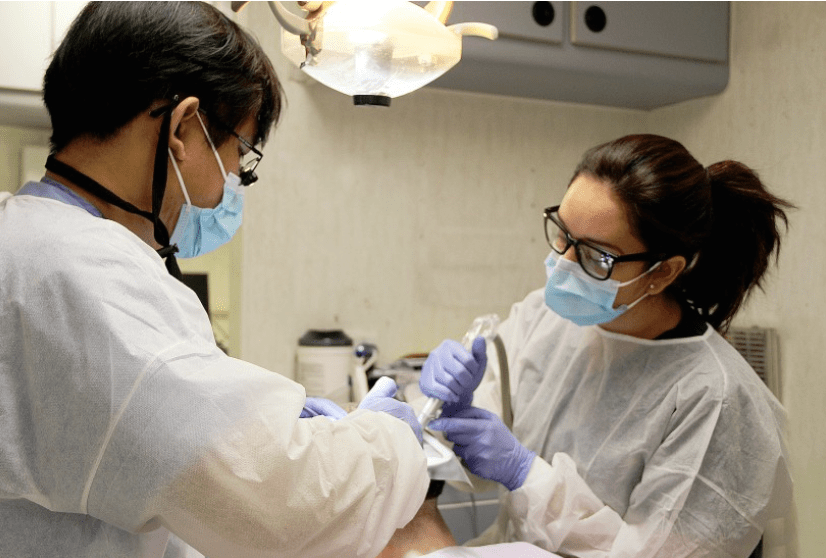From 2001 to 2009, Erick Andino served two tours of duty, nursing his fellow soldiers back to health as a U.S. Navy Corpsman during the Afghanistan and Iraq wars.
Five years later, when the former war medic needed relief from a painful cavity, he discovered his options were surprisingly limited — at least within U.S. borders.
“The pain was so bad that I actually went to T.J. [Tijuana] because they offer dental care at about half the price,” Andino said.
Cutting corners can be costly
But the trip across the border wasn’t the fix he wanted. Andino now needs a root canal — to fix the first botched job — plus another filling.
It was one of the main reasons the 31-year-old veteran made his way to the Los Angeles Convention Center in late December to seek dental care at the Los Angeles Veteran and Families Stand Down.
For three full days, the convention center’s cavernous Kentia Hall was partitioned off with dark blue curtains — each area offering a different service for struggling or homeless veterans.
In one area, there were portable shower stalls. In another, veterans picked through a mountain of donated clothes. In still another, service members sat in chairs as well-coiffed stylists wet and cut their hair. There were informational booths for everything from housing to employment assistance to mental health services.
Parked in the center of it all were four mobile dental clinics, emblazoned with the Herman Ostrow School of Dentistry of USC logo.
It’s outside these clinics that Andino sat, alongside dozens of other veterans, eager for the chance to be free of dental pain.
Bridging the gap
While the U.S. Department of Veterans Affairs offers comprehensive dental care to certain veterans — including those with service-connected dental disabilities and former prisoners of war — many do not qualify, according to the department’s website.
To help bridge that gap to dental care, the federal government launched a three-year pilot program granting veterans access to low-cost dental insurance with Delta Dental or MetLife beginning Jan. 1, 2014.
Through the VA Dental Insurance Program, individuals pay anywhere from $8.65 to $52.90 a month — depending on where they live — for dental coverage. According to the VA website, the program could mean affordable dental visits for 8 million veterans and their nearly 400,000 spouses and children.
But for the many vets facing unemployment, homelessness, mental illness or worse, even these monthly rates are out of reach.
Andino is unemployed — though he recently earned his associate’s degree in fire science and hopes to land a job with a fire department.
He admits it’s been a struggle adjusting to postwar civilian life.
“My biggest difficulty has been finding where I fit in,” he said. “In the military, I knew my role. Every day there was a plan. You knew what you were going to wear. You knew what you were going to eat. Out here, you’ve got to find your groove again.”
He said events like the Stand Down were very important — not only for the services it offered former soldiers but also to remind them they’re not alone.
Community outreach
Nearly 200 patients were treated for restorations, extractions and root canals during the Stand Down.
The Ostrow team worked under the supervision of Ostrow faculty members. There was also a significant contingency from endodontics and oral surgery residents and faculty.
“This effort to help the homeless and indigent veterans epitomizes the community values of not only the Herman Ostrow School of Dentistry, but [also] USC as a whole,” said Santosh Sundaresan ’05, section chair of community programs and director of the USC mobile clinic, in an email to the Ostrow community.
Sundaresan was the event organizer and coordinator for the Stand Down. He explained he was driven in part by his patriotism to participate in such events.
“We are a great nation and one of the reasons for this is the service and sacrifice of our veterans. It’s important to give back for all that they have done for us,” he said.
By: John Hobbs
